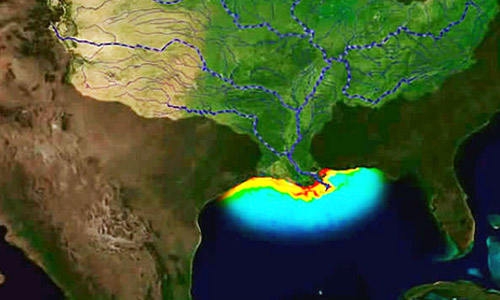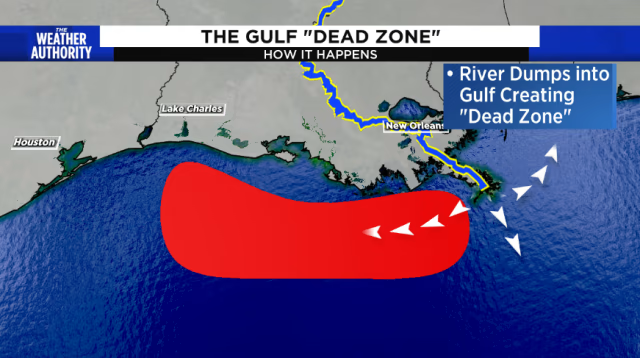Gulf Dead Zone 2025 The National Oceanic and Atmospheric Administration (NOAA), along with multiple research partners, has released its latest findings on the 2025 Gulf of Mexico Dead Zone. The annual report reveals troubling statistics about one of the largest environmental challenges facing the United States.
The Gulf Dead Zone refers to a massive area of hypnotic water, meaning oxygen levels are too low to support most marine life. It occurs annually during summer and is mainly driven by nutrient pollution from agricultural runoff. This year, researchers identified seven key findings, some of which signal an urgent need for environmental policy change and conservation strategies.
What Is the Gulf Dead Zone and Why It Matters
The Gulf Dead Zone is located off the coast of Louisiana and sometimes stretches toward Texas. It is formed when nutrient pollution, especially nitrogen and phosphorus from rivers like the Mississippi, reaches the warm Gulf waters. These nutrients fuel massive algal blooms, which eventually die and decompose, depleting oxygen from the water.
Low oxygen conditions threaten:
- Marine ecosystems
- The fishing and shrimping industries
- Coastal economies
In 2025, the Dead Zone measured more than expected, raising concern among environmentalists, government agencies, and the seafood industry alike.
NOAA’s 2025 Measurement: Bigger Than Predicted
Each summer, NOAA uses research vessels, underwater sensors, and satellite imagery to estimate the size of the Gulf Dead Zone. This year’s monitoring cruise took place in early July, covering over 4,500 nautical miles.
2025 Key Measurement:
- Area: 6,620 square miles
- Expected: 5,000 square miles
- Difference: 32% larger than predicted
This makes the Gulf Dead Zone 2025 one of the largest recorded in the past five years. NOAA scientists had forecaster a smaller area based on spring nutrient levels, but early-season weather and water temperature likely contributed to the rapid growth.

Top 7 Alarming Findings from the 2025 Gulf Dead Zone Report
1. Dead Zone Grew 32% Beyond Forecast
This year’s Dead Zone expanded well beyond initial expectations, indicating that prediction models may need to be updated to include more climate-related factors.
2. Early Algal Blooms Detected in May
Unseasonal warmth and heavier-than-average rainfall in April and May triggered premature algal growth.
3. Oxygen Levels Hit Record Lows in Certain Zones
Some parts of the Dead Zone recorded dissolved oxygen levels below 0.5 mg/L fatal for most aquatic species.
4. Commercial Fishing Areas Affected
The expansion of the hypoxic zone overlapped with key fishing zones. Fishermen have reported reduced catches of shrimp and other bottom-dwelling species.
5. River Runoff Increased by 18%
The Mississippi River carried significantly higher nutrient loads this spring due to heavy rainfall in the Midwest. This directly fueled algal blooms.
6. New Hotspots Emerged
In 2025, NOAA detected three new hypoxic zones forming off the Texas coast, not typically part of the Dead Zone region.
7. Microplastic Interaction Intensifies Hypoxia
Research also suggests that microplastics are worsening the situation by disrupting oxygen cycles and promoting more algal growth.
Why This Matters: Economic and Environmental Impact
The Gulf Dead Zone 2025 is not just an environmental concern it’s an economic threat. The Gulf of Mexico supports:
- A multi-billion-dollar seafood industry
- Over 40% of U.S. commercial fishing
- Thousands of tourism-related jobs
Dead Zones reduce the availability of fish and shellfish, force marine species to migrate, and damage coral reefs and sea grass beds. With the zone growing each year, livelihoods are at stake.
Who Is Responsible? Agriculture and Industrial Runoff
The primary source of nutrient pollution is agricultural runoff mainly from fertilisers used in the Mississippi River Basin. Other contributors include:
- Urban wastewater
- Livestock waste
- Industrial discharge
These sources combine and enter the Gulf through the Mississippi and Atchafalaya Rivers.
The Bigger Problem:
Despite federal programs and funding, nutrient management remains inconsistent across the 31 states that drain into the Mississippi River.

What Are NOAA and Partners Doing About It?
NOAA collaborates with several partners for monitoring and research:
- Louisiana Universities Marine Consortium (LUMCON)
- U.S. Geological Survey (USGS)
- Environmental Protection Agency (EPA)
- Gulf state environmental agencies
In 2025, NOAA used advanced technologies, including:
- High-resolution underwater oxygen sensors
- Satellite heat mapping
- AI data prediction models
These tools help identify problem areas and shape future strategies.
Policy Response: Are We Doing Enough?
The federal government has implemented voluntary nutrient reduction programs under the Mississippi River/Gulf of Mexico Watershed Nutrient Task Force, aiming to reduce nutrient pollution by 20% by 2035. However, results have been slow.
Challenges Include:
- Lack of enforcement on voluntary programs
- Limited state-level cooperation
- Funding delays for restoration projects
Environmental advocates argue that stronger regulations are needed, especially on agricultural runoff.
What Can Be Done Now? Solutions for the Gulf Dead Zone
While the 2025 report brings grim news, scientists and policy experts suggest several solutions:
- Stronger regulations on fertiliser use
- Funding for wetland restoration and buffer zones
- Upgrades to wastewater treatment facilities
- State-level nutrient reduction incentives
- Public awareness campaigns
Individual farmers can also adopt precision agriculture methods to reduce runoff.
What the Future Holds: A Call to Action
The Gulf Dead Zone 2025 findings are a call to action for everyone from farmers in Iowa to fishers in Louisiana. If immediate action isn’t taken, the Dead Zone could reach irreversible levels within the next decade.
The Urgent Need:
- Better prediction systems
- Aggressive nutrient reduction goals
- Federal-state coordination
- Support for impacted industries
Public Reaction: Concern and Demands for Change
Public and expert reactions have been strong following the NOAA announcement.
Environmental groups demand stricter enforcement, fishermen want compensation and early warning systems, while scientists push for better investment in long-term data gathering.
The Gulf Dead Zone 2025 has brought the conversation back to the surface: this is not just a seasonal event it’s a growing crisis that must be addressed now.
Conclusion: NOAA’s 2025 Gulf Dead Zone Report Is a Wake-Up Call
The 2025 NOAA report on the Gulf Dead Zone reveals that things are worsening faster than expected. It highlights the complexity of the issue and how deeply it is connected to agriculture, climate, and coastal industries.
If we want to preserve marine biodiversity and protect the economy of the Gulf states, comprehensive and coordinated action is necessary. NOAA’s efforts are a crucial piece of the puzzle, but now the responsibility must be shared by all farmers, lawmakers, scientists, and citizens.
Do follow Gulf Magazine on Instagram
Also Read – Cessna Caravan Starlink: 5 Game-Changing Benefits for Operators


